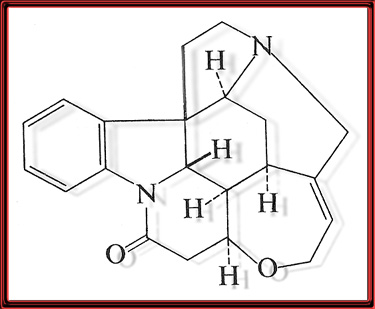Strychnine is a poisonous alkaloid that is obtained from seeds of the nux vomica tree (S. nux-vomica) and related plants of the genus Strychnos. It was discovered by the French chemists Joseph-Bienaimé Caventou and Pierre-Joseph Pelletier in 1818 in Saint-Ignatius'-beans (S. ignatii), a woody vine of the Philippines. The nux vomica tree of India is the chief commercialsource. It is practically insoluble in water and is soluble only with difficulty in alcohol and other common organic solvents. It has an exceptionally bitter taste. It is also interesting that curare, a poison used by the Amazon indians, is also derived from another tree of the Strychnos family, i.e. Strychnos toxifera. Alkaloids have diverse and important physiological effects on humans and other animals. Well-known alkaloids include morphine, strychnine, quinine, ephedrine, and nicotine.Strychnine has been used in rodent poisons and in smaller doses as a stimulant in veterinary practice. It increases the reflex irritability of the spinal cord, which results in a loss of normal inhibition of the body's motor cells, causing severe contractions of the muscles; arching of the back is a common symptom of poisoning. Strychnine rapidly enters the blood, whether taken orally or by injection, and symptoms of poisoning usually appear within 20 minutes. The symptoms begin with cramps and soon culminate in powerful and agonizing convulsions that subside after a minute but recur at a touch, a noise, or some other minor stimulus. Death is usually due to asphyxiation resulting from continuous spasms of the respiratory muscles.
Along with a lot of other chemicals Strychnine is now banned under the Biocide Directive.
Chemical Name: Strychnidin-10-one
Chemical Formula: C21H22N2O2
Chemical Structure:
- The acute oral LD50 in two studies of rats treated with strychnine alkaloid is 2.2 and 5.8 mg/kg in females, and 6.4 and 14 mg/kg in males.
- Acute dermal toxicity: The acute dermal LD50 in one study was greater than 2,000 mg/kg in albino rabbits. Dermal irritation was minimal with absent or transient erythema. In white mice, dry powder was not absorbed through the skin, but the mice died after dermal application of 1:200 to 1:1,000 concentrations of strychnine in mixtures of alcohol and essential oils, eugenol or anethole which aid skin penetration.
- Carcinogenicity: There is no evidence on carcinogenicity.
- Developmental: Studies in mammals have shown no evidence that strychnine produces developmental abnormalities. One study in chick embryos indicated that hatching and development were normal after injecting up to 3 mg of strychnine nitrate, whereas another showed several malformations when strychnine was applied after more than 48 hours incubation. Some studies in chick embryos exposed to strychnine have indicated minor effects on electrical activity in the nerves.
- Reproduction: Strychnine does not appear to affect mating behavior, reproduction or conception in rats or heifers.
- Mutagenicity: There are no reports on mutagenicity by strychnine.
Human Effects: Strychnine blocks inhibitory nerve impulses and may produce sensitization to the excit atory impulses in humans. Symptoms of strychnine poisoning begin 15 to 30 minutes after ingestion. There may be an initial violent convulsion, but frequently symptoms begin with restlessness, apprehension, heightened perception (hearing, vision, etc.),abrupt movements, exaggerated reflexes, muscular stiffness of face and legs, and rarely vomiting. Minor stimulation may trigger violent convulsions. Move ments may be intermittent at first, but then there is hyperextension, with the body arched convexly, resting on head and heels, the legs extended, arms flexed over chest or rigidly extended, fists clenched, jaw clamped, the face fixed in a grin, and the eyes bulging. Breathing stops and the patient turns blue. The muscles relax completely between convulsions, there is cold sweat, and the pupils may contract. After 10 to 15 minutes, hypersensitivity returns with further convulsions. There may be one to ten such attacks before recovery or death from respiratory arrest (suffocation). The fatal dose is usually in the range of 100-200 mg, but as little as 30 mg in adults and 15 mg in children has proved fatal.
DANGER:
STRYCHNINE IS A CONVULSIVE POISON. FATAL IF SWALLOWED, IF THE DUST IS INHALED OR IF ABSORBED THROUGH THE SKIN.
Protective precautions for workers: Avoid contact with eyes, skin or clothing. Avoid breathing dust. Do not rub eyes or mouth with hands. If you feel sick in any way, STOP work and get help right away. Wear rubber gloves, long-sleeved protective clothing, and a dust respirator type mask. Before removing gloves, wash them with soap and water. Wash arms, hands and face thoroughly with soap and water before eating or accepting anything by mouth or smoking. Remove all clothes and shoes after work. Shower with soap and water. Wash protective clothing and equipment with soap and water after each use. Clean respirator and replace filters. Launder personal clothing worn during use separately from household articles.
Medical treatment procedures (antidotes): In rendering any emergency first aid treatment, avoid self-exposure to strychnine. Keep patient in a quiet dark area if possible. Any unnecessary disturbance, distractions or sensory inputs may provoke seizures.
If swallowed: Call a physician/doctor immediately or RUSH patient to a hospital or local health centre.
If less than ten (10) minutes has passed since poison was taken, give 1 to 2 glasses of water and induce vomiting by touching back of throat with finger. Repeat until vomit fluid is clear. Have patient lie down in quiet, darkened room and keep warm and quiet. Do not attempt to induce vomiting or give anything by mouth if patient is unconscious or having seizures.If inhaled: Remove victim to fresh air. Apply artificial respiration if indicated.
If in eyes: Flush eyes with plenty of lukewarm water for at least 15 minutes. Get medical attention if irritation persists.
If on skin: Remove contaminated clothing and wash affected areas thoroughly with soap and water.
If you are a Pest Controller
When storing strychnine, always keep it locked, out of the reach of children and pets, and sealed properly so that it does not contaminate other substances such as fertilizers or food. Never order or buy more strychnine than is needed for a job, in fact try to make sure that the bottle is empty with the last worm you use....remember even residual amounts are accountable and dangerous, so don't keep stocks, after all it only takes a day or so to obtain enough for a specific job.

